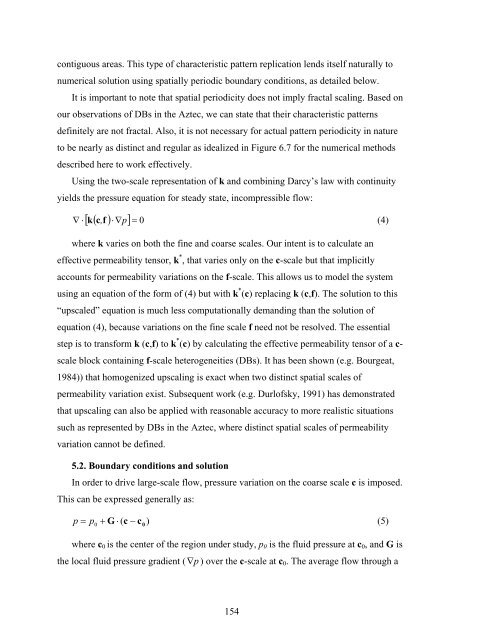structural geology, propagation mechanics and - Stanford School of ...
structural geology, propagation mechanics and - Stanford School of ...
structural geology, propagation mechanics and - Stanford School of ...
Create successful ePaper yourself
Turn your PDF publications into a flip-book with our unique Google optimized e-Paper software.
contiguous areas. This type <strong>of</strong> characteristic pattern replication lends itself naturally to<br />
numerical solution using spatially periodic boundary conditions, as detailed below.<br />
It is important to note that spatial periodicity does not imply fractal scaling. Based on<br />
our observations <strong>of</strong> DBs in the Aztec, we can state that their characteristic patterns<br />
definitely are not fractal. Also, it is not necessary for actual pattern periodicity in nature<br />
to be nearly as distinct <strong>and</strong> regular as idealized in Figure 6.7 for the numerical methods<br />
described here to work effectively.<br />
Using the two-scale representation <strong>of</strong> k <strong>and</strong> combining Darcy’s law with continuity<br />
yields the pressure equation for steady state, incompressible flow:<br />
[ ( c,f<br />
) ⋅ ∇ = 0<br />
∇ ⋅ k p]<br />
(4)<br />
where k varies on both the fine <strong>and</strong> coarse scales. Our intent is to calculate an<br />
effective permeability tensor, k * , that varies only on the c-scale but that implicitly<br />
accounts for permeability variations on the f-scale. This allows us to model the system<br />
using an equation <strong>of</strong> the form <strong>of</strong> (4) but with k * (c) replacing k (c,f). The solution to this<br />
“upscaled” equation is much less computationally dem<strong>and</strong>ing than the solution <strong>of</strong><br />
equation (4), because variations on the fine scale f need not be resolved. The essential<br />
step is to transform k (c,f) to k * (c) by calculating the effective permeability tensor <strong>of</strong> a c-<br />
scale block containing f-scale heterogeneities (DBs). It has been shown (e.g. Bourgeat,<br />
1984)) that homogenized upscaling is exact when two distinct spatial scales <strong>of</strong><br />
permeability variation exist. Subsequent work (e.g. Durl<strong>of</strong>sky, 1991) has demonstrated<br />
that upscaling can also be applied with reasonable accuracy to more realistic situations<br />
such as represented by DBs in the Aztec, where distinct spatial scales <strong>of</strong> permeability<br />
variation cannot be defined.<br />
5.2. Boundary conditions <strong>and</strong> solution<br />
In order to drive large-scale flow, pressure variation on the coarse scale c is imposed.<br />
This can be expressed generally as:<br />
p = p 0 + G ⋅ (c − c 0 ) (5)<br />
where c0 is the center <strong>of</strong> the region under study, p0 is the fluid pressure at c0, <strong>and</strong> G is<br />
the local fluid pressure gradient ( ∇p ) over the c-scale at c0.<br />
The average flow through a<br />
154
















